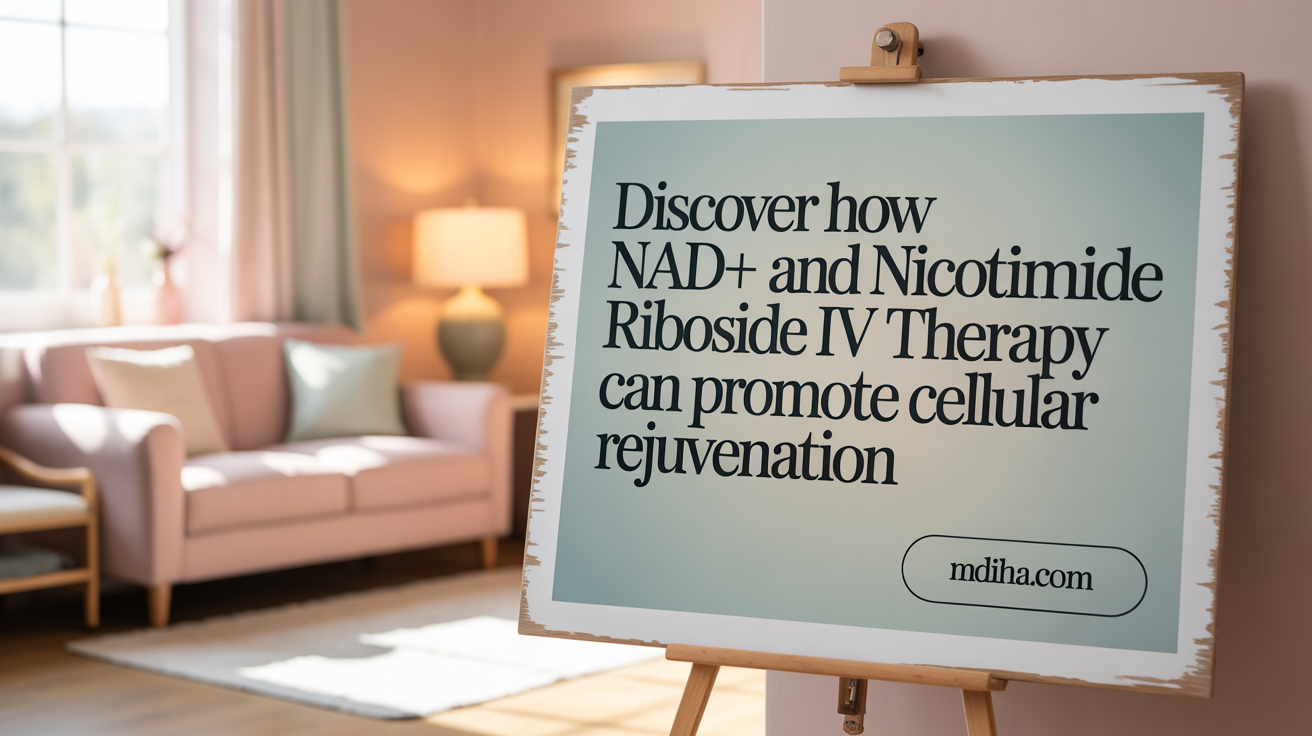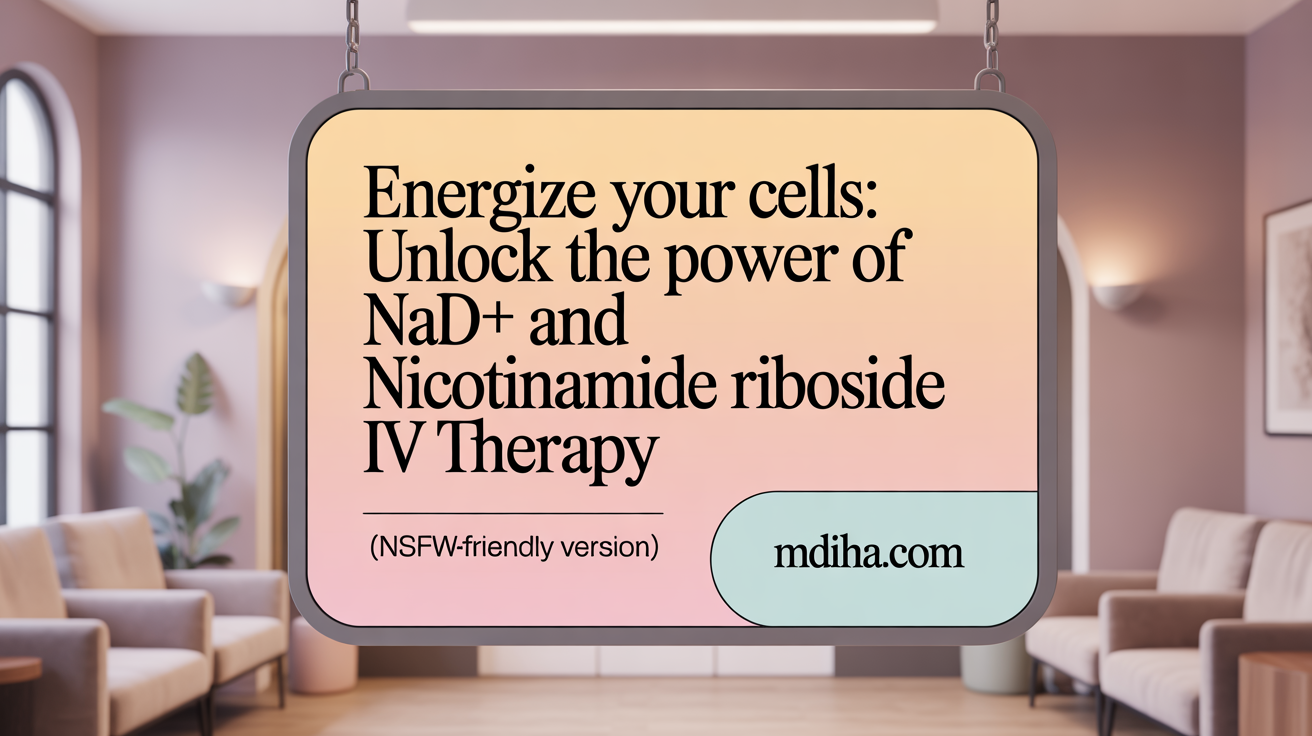Rejuvenating Energy at the Cellular Level
In the quest for enhanced wellness and longevity, NAD⁺ and Nicotinamide Riboside IV therapy have emerged as promising treatments that target fundamental cellular processes. This article explores how these therapies work, their benefits, safety considerations, and what current research reveals about their role in supporting energy, aging, and overall health.
Understanding NAD⁺ and Nicotinamide Riboside IV Therapy

What is NAD⁺ and Nicotinamide Riboside?
NAD⁺ (Nicotinamide Adenine Dinucleotide) is an essential molecule present in every cell, crucial for energy production, DNA repair, and maintaining cell health. As a coenzyme, it helps convert food into cellular energy (ATP) and supports the functioning of enzymes involved in cellular repair and regulation. Nicotinamide Riboside (NR) is a precursor to NAD⁺; it is a form of vitamin B3 that, when supplemented, can increase NAD⁺ levels in the body. This boost can support healthy aging, improve mitochondrial function, and enhance cellular vitality.
Role of NAD⁺ in the body
NAD⁺ plays numerous roles including supporting energy metabolism, DNA repair, and regulating inflammation and cell survival. Its levels naturally decline with age, stress, or illness, sometimes leading to fatigue, cognitive decline, and slower recovery. Increasing NAD⁺ levels can improve mitochondrial efficiency, bolster brain health, reduce signs of aging, and enhance overall vitality. Its role in activating sirtuins—proteins linked to longevity—makes it a promising target in anti-aging therapies.
What IV therapy entails
NAD⁺ IV therapy involves delivering NAD⁺ directly into the bloodstream via an infusion procedure, typically lasting 1 to 2 hours. This method allows for nearly 100% absorption, bypassing the digestive system, and providing rapid cellular support. The process begins with a consultation, followed by personalized dosing administered through a sterile IV environment. Patients are monitored during and after the session for safety and comfort. Common benefits include increased energy, mental clarity, better sleep, faster recovery, and improved skin health. Mild side effects such as nausea, flushing, or discomfort at the IV site are usually temporary. This therapy is often performed periodically, with initial sessions weekly or bi-weekly, then transitioning to monthly maintenance. It is generally safe when administered by trained medical professionals.
Applications and promise in medicine
Research indicates promising applications of NAD⁺ and NR IV therapy for a variety of conditions related to aging, metabolic health, and neurodegeneration. It is used to support anti-aging efforts, improve cognitive function, assist in addiction recovery, and improve skin quality. Scientific studies, including those from Harvard Medical School and the National Institutes of Health, show that boosting NAD⁺ can enhance mitochondrial function, reduce oxidative stress, and promote healthy aging. While more extensive human trials are ongoing, early evidence suggests that NAD⁺ supplementation can be a valuable addition to integrative and preventive healthcare strategies, potentially unlocking new ways to manage age-related decline and improve overall wellness.
The Cellular Powerhouse: How NAD⁺ and Nicotinamide Riboside IV Therapy Energize Cells
 NAD⁺, or Nicotinamide Adenine Dinucleotide, is a vital coenzyme found in every cell that plays a central role in energy production. It acts as a molecular shuttle, transferring electrons during cellular respiration within mitochondria—the cell’s powerhouses. As we age, or due to stress and illness, NAD⁺ levels decline, leading to reduced mitochondrial efficiency and decreased energy output.
NAD⁺, or Nicotinamide Adenine Dinucleotide, is a vital coenzyme found in every cell that plays a central role in energy production. It acts as a molecular shuttle, transferring electrons during cellular respiration within mitochondria—the cell’s powerhouses. As we age, or due to stress and illness, NAD⁺ levels decline, leading to reduced mitochondrial efficiency and decreased energy output.
Nicotinamide Riboside (NR) IV therapy offers a way to replenish NAD⁺ directly into the bloodstream, bypassing the digestive system for rapid absorption. This infusion elevates cellular NAD⁺ levels, which is crucial for maintaining mitochondrial health and activity. Increased NAD⁺ supports the production of ATP, the energy currency of cells, thus re-energizing tired tissues and boosting overall vitality.
One of the remarkable effects of higher NAD⁺ levels is the activation of enzymes like sirtuins and PARPs. Sirtuins regulate gene expression related to aging, metabolism, and stress resistance, helping cells adapt and repair more effectively. PARPs are involved in DNA repair, protecting cells from damage. By activating these enzymes, NAD⁺ enhances the cell’s ability to maintain integrity and function.
Elevated NAD⁺ also promotes mitochondrial biogenesis—the creation of new mitochondria—further improving the cell’s capacity to generate energy. This process supports neurological health, muscle strength, and skin repair, contributing to healthier aging.
Through IV therapy, systemic NAD⁺ levels can be quickly restored, supporting tissues across the body. This approach not only improves energy levels and mental clarity but also offers potential benefits in combating age-related cellular decline. As research progresses, NAD⁺ IV therapy remains a promising strategy for revitalizing cellular function and promoting long-term health.
Health Benefits and Advantages of NAD⁺ and Nicotinamide Riboside IV Therapy

What are the health benefits and potential advantages of NAD⁺ and Nicotinamide Riboside IV therapy?
NAD⁺ and Nicotinamide Riboside (NR) IV therapy provide numerous health benefits that support overall vitality and healthy aging. These therapies work by boosting cellular energy production, promoting DNA repair, and enhancing mitochondrial function—crucial processes for maintaining cellular health.
As we age, NAD⁺ levels naturally decrease, partly due to increased activity of enzymes like CD38 that break down NAD⁺. Lower NAD⁺ levels are linked to signs of aging such as cellular senescence, genomic instability, and reduced mitochondrial efficiency. Restoring NAD⁺ through IV therapy can help counteract these effects, leading to improved cellular resilience and longevity.
Animal studies and early human trials indicate that NAD⁺ therapy can benefit cardiovascular health by reducing inflammation and supporting blood vessel function. It also fosters tissue regeneration, helps protect nerve cells, and supports brain health by improving mental clarity and reducing neuroinflammation.
In addition to neurological benefits, NAD⁺ therapies aid skin health through enhanced DNA repair and collagen synthesis, which can reduce age-related skin damage. They also promote muscle vitality by increasing energy availability and encouraging mitochondrial biogenesis.
While initial results are promising, ongoing research aims to better understand the long-term safety and efficacy of NAD⁺ and NR IV therapy. Nonetheless, these treatments are gaining popularity as promising tools in the fight against age-related decline.
| Benefits | Description | Supporting Evidence |
|---|---|---|
| Anti-aging effects | Slows cellular aging and improves lifespan | Animal studies; human pilot trials |
| DNA repair enhancement | Repairs damaged DNA, reduces mutations | Cellular studies showing PARP activation |
| Mitochondrial function support | Boosts energy production, mitochondrial biogenesis | NIH-funded studies; animal models |
| Neurological and cardiovascular benefits | Improves brain health and heart function | Clinical trials; animal models |
| Skin and muscle health | Enhances collagen, reduces signs of aging, supports muscle vitality | Skin cell studies; clinical observations |
In conclusion, NAD⁺ and NR IV therapy hold significant promise for improving cellular health, reducing aging signs, and supporting long-term wellness. As research advances, these treatments could become vital components of anti-aging and regenerative medicine.
Safety Profile and Potential Risks of NAD⁺ and Nicotinamide Riboside IV Therapy

What safety considerations and potential risks are associated with NAD⁺ and Nicotinamide Riboside IV therapy?
NAD⁺ and Nicotinamide Riboside (NR) IV therapies are generally considered safe when performed by experienced medical professionals. Most side effects are mild and tend to resolve quickly. Common issues include nausea, headaches, flushing, dizziness, and minor reactions at the injection site.
These therapies involve delivering NAD⁺ directly into the bloodstream, which facilitates rapid absorption and cellular support. Although severe adverse reactions are rare, patients should be aware of potential allergic responses, gastrointestinal discomfort, and local irritation.
To reduce risks, proper hydration and controlled infusion rates are crucial. Communicating with healthcare providers about allergies, medical history, or underlying health conditions helps ensure safe administration. Patients with autoimmune disorders, liver issues, pregnancy, or breastfeeding should consult their doctor beforehand.
Risks and contraindications
While clinical data supports the safety of NAD⁺ IV administration, certain conditions warrant caution. High doses of NAD⁺ might interact with medications or exacerbate specific health issues. For example, individuals with active cancer or compromised immune systems should avoid NAD⁺ therapies unless supervised by their healthcare provider.
Contraindications include autoimmune diseases, active infections, or liver and kidney impairments. High-dose Niacin, a related compound, may cause liver stress, so medical assessment is recommended prior to treatment.
Precautions and safety protocols
To maximize safety, clinics should follow sterile procedures, carefully monitor infusion rates, and tailor doses to individual needs. Continuous monitoring during treatment can detect early signs of adverse reactions.
Patients should be advised to stay hydrated, avoid strenuous activity immediately after infusion, and report any unusual symptoms promptly. Incorporating complementary safety practices like pre-treatment screenings and post-treatment follow-up is vital.
Long-term safety considerations
Currently, evidence on the long-term effects of NAD⁺ IV therapy is limited. Although short-term benefits are documented and side effects are minimal, ongoing research is needed to understand prolonged use.
Repeated or chronic treatments should be overseen carefully to prevent potential interactions, immune responses, or unintended consequences. As the therapy becomes more common, establishing long-term safety profiles will enhance confidence and enable more tailored approaches.
In summary, NAD⁺ and NR IV therapies are generally safe with proper oversight, but patients must adhere to clinical protocols to mitigate risks and ensure the best outcomes.
The Therapy Experience: What to Expect During NAD⁺ and Nicotinamide Riboside IV Sessions

What is the typical process and procedure for NAD⁺ and Nicotinamide Riboside IV therapy sessions?
NAD⁺ and Nicotinamide Riboside (NR) IV therapy sessions typically involve delivering a slow infusion of the coenzyme directly into the bloodstream. The procedure lasts approximately 1.5 to 3 hours, allowing the nutrients to bypass the digestive system for higher cellular uptake. Patients usually recline comfortably during the infusion, which is administered gradually to reduce the risk of side effects like nausea or flushing.
Before the session begins, a healthcare professional reviews the patient’s medical history to ensure safety. The infusion is personalized based on individual health goals and needs. For the initial phase, treatments may be scheduled weekly for several weeks, each lasting about 1.5 to 3 hours. As NAD+ levels increase, doctors often recommend maintenance infusions spaced out monthly to sustain the benefits.
Throughout the session, practitioners monitor the patient for mild side effects such as warmth, dizziness, or slight discomfort at the IV site. The overall goal is to support mitochondrial function, DNA repair, and cognitive health while maintaining patient comfort.
NAD⁺ and Nicotinamide Riboside IV Therapy in Aging, Metabolism, and Wellness
What role do NAD⁺ and Nicotinamide Riboside IV therapy play in aging, energy metabolism, and overall wellness?
NAD⁺, or Nicotinamide Adenine Dinucleotide, is a crucial coenzyme present in all cells that supports energy production, DNA repair, and cellular health. Its levels naturally decline with age, stress, and illness, which can result in fatigue, cognitive issues, and slower recovery.
Nicotinamide Riboside (NR) is a form of vitamin B3 that serves as a precursor to NAD⁺. Supplementing with NR or delivering NAD⁺ directly through IV therapy can boost tissue NAD⁺ levels, helping to restore cellular function. These therapies target age-related deficits, aiming to improve mitochondrial activity, promote neuroprotection, and enhance immune health.
NAD⁺ IV therapy involves infusing NAD⁺ directly into the bloodstream, allowing for rapid absorption and higher bioavailability compared to oral supplements. This method supports mitochondrial function—fueling the energy factories of cells—and can repair damaged DNA, which is essential as we age.
While the scientific community continues to explore the full scope of benefits, early evidence suggests that NAD⁺ boosting treatments could extend healthspan, reduce fatigue, improve mental clarity, and protect against age-related diseases. Both NAD⁺ and NR therapy are quickly gaining attention as innovative strategies for promoting whole-body vitality and slowing the aging process.
Scientific Evidence Supporting NAD⁺ and Nicotinamide Riboside IV Therapy
What scientific research supports the use and benefits of NAD⁺ and Nicotinamide Riboside IV therapy?
Recent scientific studies provide promising evidence for the benefits of NAD⁺ and its precursors, particularly Nicotinamide Riboside (NR), in supporting health and aging. Clinical trials have shown that supplementing with NAD⁺ precursors like NR and NMN can safely elevate NAD⁺ levels in humans. These increases are dose-dependent, meaning higher doses lead to greater NAD⁺ levels in the bloodstream.
The enhancement of NAD⁺ has been linked to multiple health benefits. For instance, improved mitochondrial function and DNA repair have been observed, which are essential for maintaining cellular vitality and preventing age-related decline. Additionally, some studies report boosts in skin health, energy, muscle strength, and neuroprotection.
Animal research further underscores these findings. Experiments with mice demonstrate that NAD⁺ boosting strategies can promote healthy aging, extend lifespan, and improve organ function. These investigations reveal that increasing NAD⁺ may combat age-associated issues such as metabolic decline and cognitive impairment.
Mechanistic insights from biochemistry explain how NAD⁺ activates sirtuins—proteins involved in aging and stress resistance—and supports enzymes necessary for DNA repair, such as PARPs. By facilitating cellular energy production (ATP synthesis) and reducing inflammation, NAD⁺ contributes to overall cellular health.
Despite these positive signs, gaps remain. Most current human studies are preliminary, often with small participant numbers or short durations. Large-scale, long-term clinical trials are essential to confirm the safety and comprehensive benefits of NAD⁺ therapy. Future research will help establish optimal dosing protocols and expand understanding of how NAD⁺ influences aging and chronic disease processes.
In summary, scientific evidence from early trials and animal models supports NAD⁺ and NR therapy as promising approaches to improve healthspan and mitigate age-related decline. Continued research is critical to translate these biological insights into standardized treatment options.
Embracing NAD⁺ and Nicotinamide Riboside IV Therapy for Vital Energy
NAD⁺ and Nicotinamide Riboside IV therapy represent a frontier in cellular health optimization, offering a scientifically grounded approach to boosting energy metabolism, supporting DNA repair, and potentially slowing some effects of aging. While clinical evidence continues to grow, the therapy’s ability to replenish declining NAD⁺ levels makes it an attractive option for individuals seeking enhanced vitality, improved cognitive clarity, and overall wellness. With proper medical guidance and adherence to safety protocols, NAD⁺ IV therapy could become a valuable part of personalized health strategies aimed at energizing cells and revitalizing life’s potential.
References
- Therapeutic potential of NAD-boosting molecules: the in vivo evidence
- How Does NAD Therapy Work? Everything You Need to Know ...
- NAD+ IV Therapy in Raleigh | NAD Plus IV Drip } Dr Jindal
- NAD IV Therapy for Energy
- Top 10 Benefits of NAD+ | Restore Hyper Wellness
- NAD+ Infusions - Medic Clinic Private GP
- The Role of NAD+ in Regenerative Medicine - PMC - PubMed Central
- What is NAD IV Therapy? - Drip Hydration
- Clinical Evidence for Targeting NAD Therapeutically - PMC
